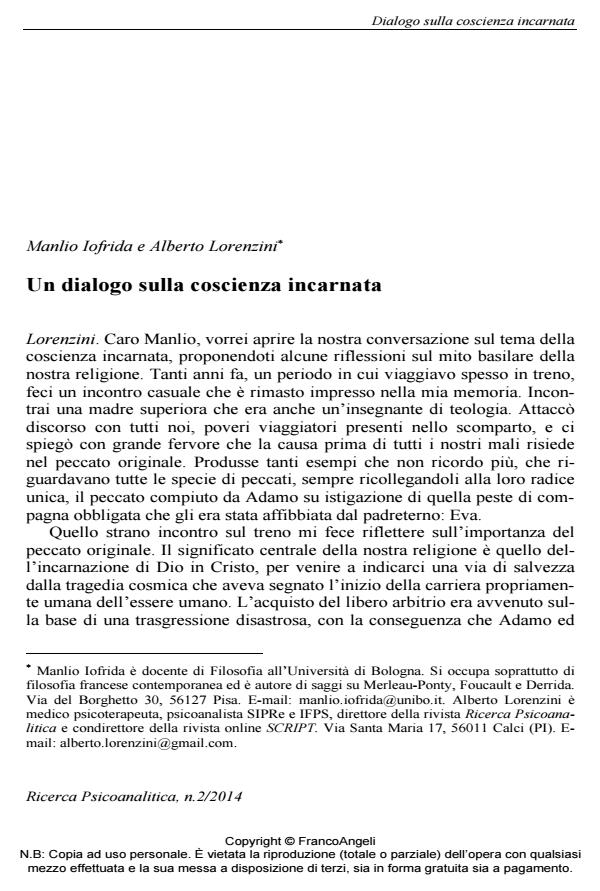Dialogue on embodied conscience
Journal title RICERCA PSICOANALITICA
Author/s Manlio Iofrida, Alberto Lorenzini
Publishing Year 2014 Issue 2014/2
Language Italian Pages 20 P. 9-28 File size 668 KB
DOI 10.3280/RPR2014-002002
DOI is like a bar code for intellectual property: to have more infomation
click here
Below, you can see the article first page
If you want to buy this article in PDF format, you can do it, following the instructions to buy download credits

FrancoAngeli is member of Publishers International Linking Association, Inc (PILA), a not-for-profit association which run the CrossRef service enabling links to and from online scholarly content.
Starting from the Christian issue of embodiment seen as a theological way of posing the question of the relation between primary conscience and higher conscience, between logos and perception, the authors relate it to infant research studies by Sanders and Tronick who highlight the extraordinary richness of procedural conscience in the pre-logic and corporeal period of communication. Also Edelman’s work with his idea of remembered present is seen as an important part of a vision inspired by Bateson that considers the relational dance a key concept for creating a new ontology where the void (as discussed by the great oriental philosopher Raimon Panikkar, whose ideas are compared to those deriving from the theatrical work of Peter Brook) takes up a basic role in that it is opposed to nothingness. The dialogue ends with a comment to some passages from The visible and the invisible by Merleau-Ponty that represent a neat philosophical synthesis of the issues discussed and, in particular, suggest the need to connect primary and secondary conscience, language logos and corporeal logos, because their separation generates very serious problems at the level of individual and social pathologies and more in general the crisis of our society.
Keywords: Embodied conscience, infant research, relational dance, remembered present, primary conscience, narrative conscience, Merleau-Ponty
- Edelman G. M. e Tononi G. (2000). Un universo di coscienza. Come la materia diventa immaginazione. Torino: Einaudi.
- Ferro A. (2010). Pensiero onirico e teoria del campo. Ricerca Psicoanalitica, 3. DOI: 10.3280/RPR2010-001004
- Fouts R. (1997). Trad. it.: La scuola delle scimmie. Come ho insegnato a parlare a Washoe. Milano: Mondadori, 1999.
- London J. (1909). Martin Eden. Trad. it. della Biblioteca di Repubblica. Roma, 2004.
- Lorenzini A. (2012). I livelli della coscienza in forma di panino: la teoria dell’azione terapeutica di Alexandra Harrison. Ricerca Psicoanalitica, 3. DOI: 10.3280/RPR-2012-003006
- Merleau-Ponty (1999). Trad. it.: Il visibile e l’invisibile. Milano: Bompiani.
- Brook S. (2013). The Tightrope. Film.
- Edelman G. M. (1989). Trad. it.: Il presente ricordato. Una teoria biologica della coscienza. Milano: Rizzoli, 1991.
- Panikkar R. (2005). La dimora della saggezza. Milano: Arnoldo Mondadori Editore.
- Panikkar R. (2006). Il silenzio del Buddha. Milano: Arnoldo Mondadori Editore.
- Lo "psicodramma" in seduta Alberto Lorenzini, in RICERCA PSICOANALITICA 3/2016 pp.41
DOI: 10.3280/RPR2016-003004 - L'holding, terreno di coltura del Sé Alberto Lorenzini, in RICERCA PSICOANALITICA 1/2015 pp.55
DOI: 10.3280/RPR2015-001005 - La coscienza incarnata: come la materia diventa immaginazione Alberto Lorenzini, in RICERCA PSICOANALITICA 1/2017 pp.29
DOI: 10.3280/RPR2017-001004
Manlio Iofrida, Alberto Lorenzini, Un dialogo sulla coscienza incarnata in "RICERCA PSICOANALITICA" 2/2014, pp 9-28, DOI: 10.3280/RPR2014-002002